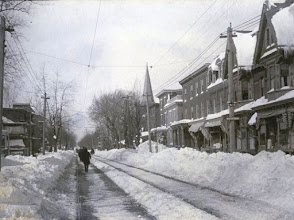Tuesday, January 29, 2013
Monday, January 21, 2013
Winter '12 / '13 - Storm #3: MR Teaser
Long-range progs continue to offer a contest-worthy storm toward week's end for the northern M-A and SNE.

UL: 500 mb Z and PMSL
UR: 500 mb Z and vorticity
LL: PMSL and precipitation type
LR: PMSL and 2m Td
Today/s 108-hour solutions from the 12z GFS suggest initial forcing from-low level warm air advection followed by a modest measure of mid-level intensification as the system approaches the SNE coast.
Should this scenario come to pass...
Call for Forecasts: Wed evening...23-JAN-13
Deadline: 10:30 PM EST Thu...24-JAN-13
---
Images courtesy Meteocentre.com
Winter '12 / '13 - Arctic Oscillation: Meteorological Winter/s Mid-point
Not sure what if anything it means but here's the state of the AO at the mid-point of meteorological winter during its 64 year period-of-record.

Blue line is the observed AO on 15-JAN.

Three things to note...
1) The highly variable AO index on D+45 compared to its sister index...then NAO.
2) The 11-year moving average between 1960 and1980 is negative...followed by a 30-year period were the average is above zero.
3) This season/s mid-winter AO and NAO values are slightly below normal for all mid-winter values during the period-of-record (Z = -0.207 and Z = -0.045, respectively).
Wednesday, January 09, 2013
Winter '12 / '13 - Stratospheric Sudden Warming: Watch #2
UPDATE #3
Current SSW event can now be classified as a major warming. Temperatures have increased ~50°C in less than seven days AND zonally averaged winds @60°N have turned easterly.

Max 10 mb (31,242m; ~50K') temperature @12z today was -22°C (-7.6°F) over Viljujsk...Russia (map).
Why is SSW matters...
Pronounced weakenings of the NH wintertime stratospheric polar vortex tend to be followed by episodes of anomalously low surface air temperatures and increased frequency of occurrence of extreme cold events throughout densely populated regions such as eastern North America, northern Europe, and eastern Asia that persist for ~2 months.http://www.nwra.com/resumes/baldwin/pubs/Thompsonetal_2002.pdf
Pronounced weakening of the PV (cool colors) as it splits in two bya strong anticyclone advancing on 90°N...

10 mg height analysis courtesy JMA.

Warm colors indicate east wind. Polar wind field along left edge of frame. Anticyclonic circulation is strongest above 10 mb and extends to surface. Blue action center near 30N @ 200 mb is the sub-tropical jet.
Height-Latitude Cross Section of Zonally Averaged Zonal Wind image courtesy JMA.
---
UPDATE #2 (7-JAN-13 @ 7:08 PM EST)

Just a hint of the warming down to ~30 mb along seen on the right edge of the above image.

Not the wave flux above 100 mb...especially in the final frame...where the 'hot' colored vectors veer toward the pole indicating energy propagating from the troposphere into the poleward Ignorosphere.
ECMWF forecasts the PV to bifurcate and maintain that state through D+10 as anticyclone builds over 90N. CW has it the anticyclone propagates to the surface in a few weeks where -AO becomes established. Some unknown location in the mid-latitudes can probably expect a Mother lode of cold toward the end of January.
---
UPDATE #1 (30-DEC-12 @ 1:58 PM EST)
Strong anticyclone forecast at D+10 (blue region in upper right of frame).
Sunday, January 06, 2013
Wednesday, January 02, 2013
Winter '12/ '13 - Arctic Oscillation: Is December A Leading Indicator?
UPDATE
December AO: -1.749
Rank: 11th (17th percentile)
---
Original post date: 26-DEC-12 @6:31 PM EST
Little doubt DEC/s index will come in negative given the 30-day moving average stands at -1.965.
Does the sign of DEC/s AO have any predictive value? The sign of NOV/s AO was shown to have predictive value for the sign meteorological winter/s (D-J-F) average AO.
The 2x2 contingency table of DEC/s AO index and JAN/s index shown below suggests there/s a strong association between the two...especially when DEC/s AO is < 0.
Each cell in the table shows the number of years where the sign of the DEC/s AO was associated with the sign of JAN/s AO.

When DEC/s AO is < 0...there/s an 82% chance the JAN/s average AO will also be negative.
The table/s precision is 74%...where precision is the proportion of negative cases predicted correctly [a / (a + c)]. The probability of a 'false positive' (-AO forecast; + AO observed) is 36%.

Winter '12 / '13 - Arctic Oscillation: Day 31
Not sure what if anything it means but here/s the state of the AO on Day 31 of meteorological winter during its 63 year period-of-record.
Winter '12 / '13 - Long Range Forecast: Farmer/s Almanac
 |
| Two Towers - New York Alfred Stieglitz OCT-1911 |
January 2013
1st-3rd. Showery, then clearing and cold. Wet for Mummers Day Parade in Philadelphia.
4th-7th. Storm sweeps across Pennsylvania and New York with gusty winds and heavy precipitation.
8th-11th. Blustery and colder; snow showers.
12th-15th. Mostly fair.
16th-19th. Wet, then fair and cold.
20th-23rd. Heavy snow (half foot or more) for New England; lighter amounts farther south.
24th-27th. Scattered flurries.
28th-31st. Sharp cold front brings rain and snow showers, then clearing and cold.
February 2013
1st-3rd. Fair.
4th-7th. A sharp cold front brings gusty winds, rain, and snow showers.
8th-11th. Unsettled; light snow and flurries.
12th-15th. Major Northeast snowstorm develops: some accumulations could exceed one foot; strong winds cause considerable blowing of snow.
16th-19th. Lingering snow showers, flurries.
20th-23rd. Blustery and cold.
24th-28th. A major storm over the ocean perhaps brushes the coast with light snow and gusty winds, then turning fair.
More...
Winter '12 / '13 - SOI: December
December/s SOI (Southern Oscillation Index) came in at -6 after three consecutive months where the index went above zero.
A negative SOI is associated with above normal sea surface temperatures (SST) in ENSO Region 3.4 in the tropical Pacific. Sustained SOI < -8 indicates el Nino.
Weekly SST anomalies from Region 3.4 have been running a tenth or two below normal the past four weeks causing the 12-week moving average to fall to 0.18 (neutral-warm).




























